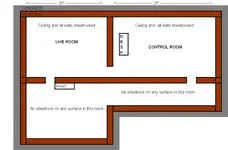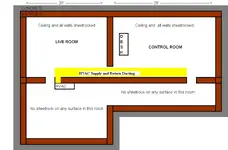P
Phyl
Guest
The basement room I plan to use as a live room is already sheetrocked. It sits in a corner of the house, so behind two of the walls is concrete foundation, behind the other two walls are other sheetrocked rooms.
After reading through a bunch of posts, I've decided to put up resilient channel on the walls and ceiling and then add one additional layer of drywall. The goal is to eliminate as much leakage as possible into the control room. I realize that this is not the optimal solution but it's all the budget will allow for now.
I want to make sure this makes sense, and insure that I'm not creating some new sonic nightmare. I've read a few old posts that talk about inadvertantly creating a triple leaf system that hurts rather than helps with sound islolation.
Comments?
After reading through a bunch of posts, I've decided to put up resilient channel on the walls and ceiling and then add one additional layer of drywall. The goal is to eliminate as much leakage as possible into the control room. I realize that this is not the optimal solution but it's all the budget will allow for now.
I want to make sure this makes sense, and insure that I'm not creating some new sonic nightmare. I've read a few old posts that talk about inadvertantly creating a triple leaf system that hurts rather than helps with sound islolation.
Comments?


